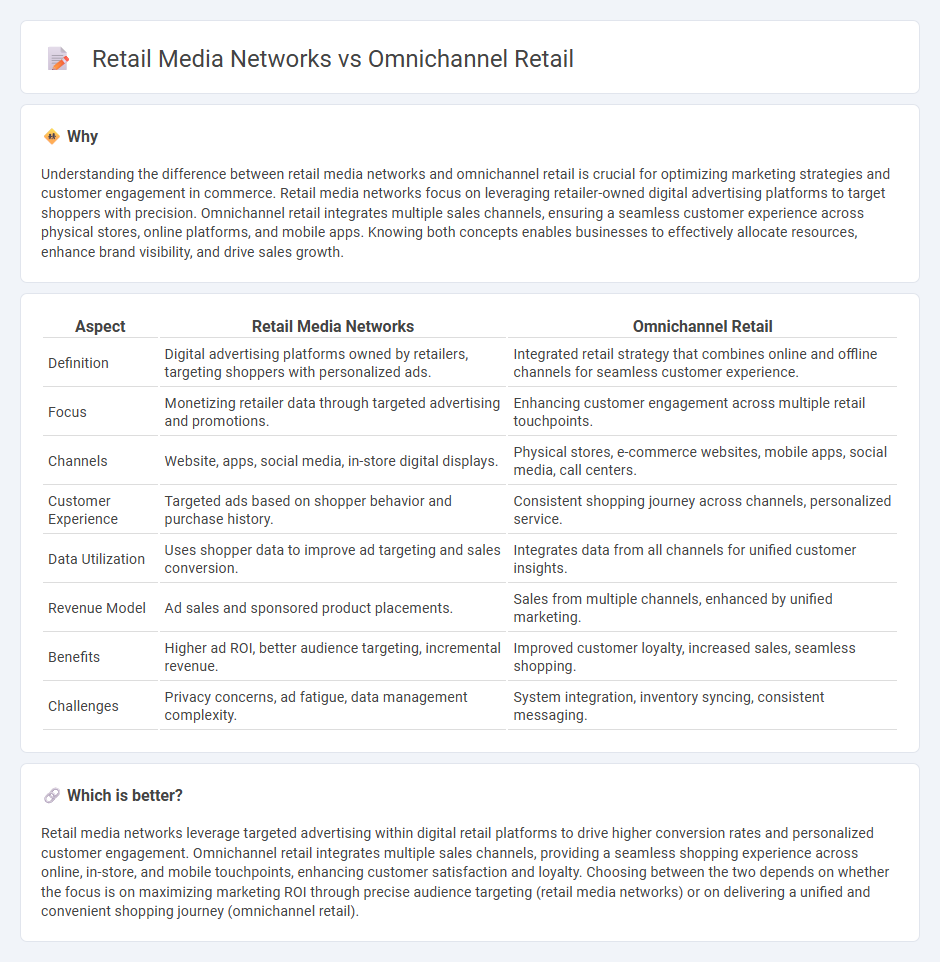
Retail media networks leverage targeted advertising within digital retail platforms to enhance customer engagement and drive sales, focusing on data-driven insights and personalized marketing. Omnichannel retail integrates multiple sales channels--physical stores, online shops, and mobile apps--to provide a seamless and consistent customer experience across touchpoints. Explore the benefits and challenges of Retail Media Networks versus Omnichannel Retail to optimize your commerce strategy.
Why it is important
Understanding the difference between retail media networks and omnichannel retail is crucial for optimizing marketing strategies and customer engagement in commerce. Retail media networks focus on leveraging retailer-owned digital advertising platforms to target shoppers with precision. Omnichannel retail integrates multiple sales channels, ensuring a seamless customer experience across physical stores, online platforms, and mobile apps. Knowing both concepts enables businesses to effectively allocate resources, enhance brand visibility, and drive sales growth.
Comparison Table
| Aspect | Retail Media Networks | Omnichannel Retail |
|---|---|---|
| Definition | Digital advertising platforms owned by retailers, targeting shoppers with personalized ads. | Integrated retail strategy that combines online and offline channels for seamless customer experience. |
| Focus | Monetizing retailer data through targeted advertising and promotions. | Enhancing customer engagement across multiple retail touchpoints. |
| Channels | Website, apps, social media, in-store digital displays. | Physical stores, e-commerce websites, mobile apps, social media, call centers. |
| Customer Experience | Targeted ads based on shopper behavior and purchase history. | Consistent shopping journey across channels, personalized service. |
| Data Utilization | Uses shopper data to improve ad targeting and sales conversion. | Integrates data from all channels for unified customer insights. |
| Revenue Model | Ad sales and sponsored product placements. | Sales from multiple channels, enhanced by unified marketing. |
| Benefits | Higher ad ROI, better audience targeting, incremental revenue. | Improved customer loyalty, increased sales, seamless shopping. |
| Challenges | Privacy concerns, ad fatigue, data management complexity. | System integration, inventory syncing, consistent messaging. |
Which is better?
Retail media networks leverage targeted advertising within digital retail platforms to drive higher conversion rates and personalized customer engagement. Omnichannel retail integrates multiple sales channels, providing a seamless shopping experience across online, in-store, and mobile touchpoints, enhancing customer satisfaction and loyalty. Choosing between the two depends on whether the focus is on maximizing marketing ROI through precise audience targeting (retail media networks) or on delivering a unified and convenient shopping journey (omnichannel retail).
Connection
Retail media networks leverage omnichannel retail strategies by integrating advertising across physical stores, e-commerce platforms, and mobile apps to enhance consumer targeting and engagement. This interconnected approach allows brands to deliver personalized ads based on comprehensive shopping behavior data collected from multiple touchpoints. Consequently, retailers can optimize marketing ROI and drive seamless customer experiences through synchronized digital and in-store interactions.
Key Terms
Customer Journey
Omnichannel retail integrates multiple customer touchpoints such as physical stores, online platforms, and mobile apps to create a seamless shopping experience, enhancing engagement throughout the entire customer journey. Retail media networks leverage targeted advertising within retailer-owned digital properties, using shopper data to deliver personalized promotions that influence purchase decisions at critical moments. Explore the nuances between these strategies to optimize customer engagement and drive sales growth effectively.
Cross-Channel Integration
Omnichannel retail emphasizes seamless cross-channel integration, combining physical stores, e-commerce, mobile apps, and social media to provide a unified customer experience. Retail media networks leverage data from these channels to deliver targeted advertising within retail environments, enhancing customer engagement and driving sales. Explore how combining omnichannel strategies with retail media networks can revolutionize marketing effectiveness and customer satisfaction.
Monetization Platforms
Omnichannel retail integrates multiple customer touchpoints, including physical stores, e-commerce, and mobile apps, to create seamless shopping experiences and drive revenue across channels. Retail media networks leverage first-party data from these touchpoints to offer targeted advertising, enhancing monetization by turning retail platforms into dynamic ad spaces. Explore deeper insights on how these monetization platforms reshape retail economics and customer engagement strategies.
Source and External Links
What is Omni-Channel Retail? - Omni-channel retailing is a model where shoppers interact seamlessly across multiple physical and digital sales channels with their information retained, enabling a unified, consistent shopping experience across devices and locations.
What is Omnichannel Retailing? Basics Explained - Omnichannel retail fully integrates all sales channels, both physical and online, through centralized data management and omnichannel POS systems to offer customers a seamless, unified shopping experience.
What Is Omnichannel Retail? How it Works and Examples ... - Omnichannel retailing is a fully integrated commerce approach that unifies all customer touchpoints to deliver exactly what customers need, wherever they are, combining physical stores, mobile devices, online marketplaces, and social media.
 dowidth.com
dowidth.com